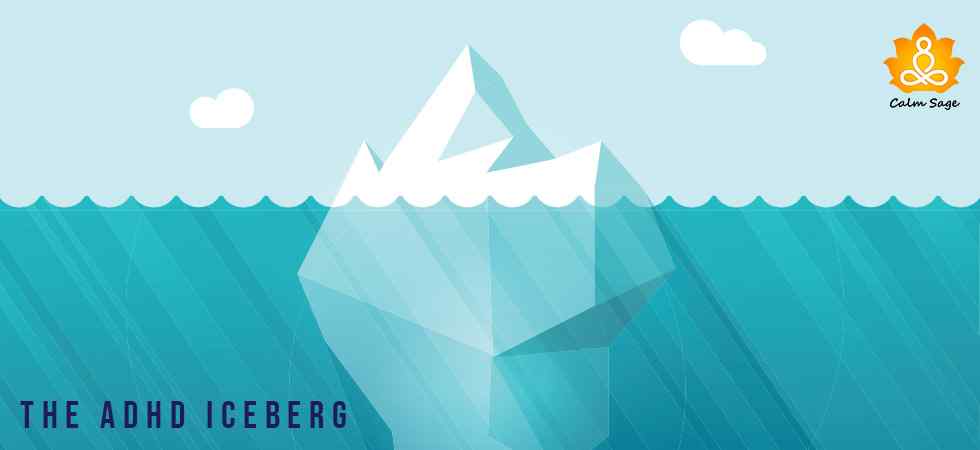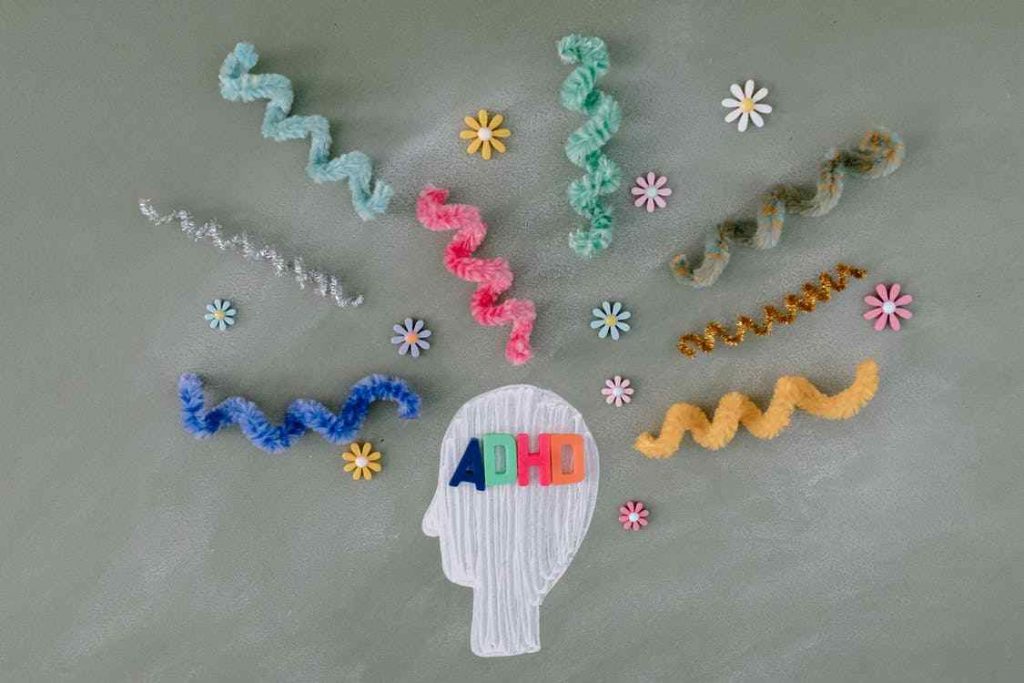Published In
ADHD

Exploring The ADHD Iceberg : Visible and Invisible Symptoms
Attention deficit hyperactivity disorder (ADHD) is a severe condition that causes difficulties in being attentive, impulsivity and hyperactivity. Now, these are not the only symptoms of ADHD, this is where the ADHD iceberg comes into play.
The symptoms of ADHD like inattentiveness, impulsiveness, hyperactivities, lack of focus, etc. form the tip of the iceberg because that’s what we know about the symptoms of ADHD. There are various hidden symptoms of ADHD which form the hidden part of the ADHD iceberg.
Today, we will brush over our general knowledge about ADHD and get a deeper understanding of the visible part of the ADHD Iceberg (external/visible symptoms of ADHD) and the submerged part of the ADHD iceberg (invisible/hidden Symptoms of ADHD).
Shall we begin?
What Is Attention Deficit Hyperactivity Disorder (ADHD)?


Like I said before, Attention Deficit Hyperactivity Disorder (ADHD) is a chronic mental health condition that affects your attention and focus, it makes you impulsive and hyperactive. ADHD usually is developed during childhood but it also affects a lot of people in their adulthood as well.
Adult ADHD differs a tad bit from childhood ADHD and if left untreated, both can be of potential danger. ADHD affects almost all aspects of your life, it affects your productivity, your relationships, your behavior in school/college, etc.
Did you know, 2.9 % of the world population is affected by ADHD? This number is from the diagnosed population, there are various people who don’t even get their mental health conditions like ADHD tested.
What Is The Meaning Of the ADHD Iceberg?
The ADHD analogy is mainly used to describe the known and hidden symptoms of ADHD. It is a metaphoric representation of what people with ADHD have to deal with. What we see on the outside is just the tips of an iceberg.
Let me explain it to you, visualize an iceberg, what you see floating above the water level represent the known/visible symptoms of ADHD like getting distracted easily, concentration & focus-related issues, impulsive behavior, daydreaming, etc.
Now, the submerged part of the iceberg is almost 75% of the entire thing. This means almost 75% of the symptoms of ADHD are hidden, they are not easily recognized or identified as ADHD symptoms. There hidden symptoms of ADHD are submerged within yourself and are not visible on the outside.
Let’s Look at the Visible and invisible symptoms of ADHD, shall we?
Visible Symptoms Of ADHD (The Tip Of The ADHD Iceberg)
There are a lot of symptoms of ADHD that are commonly identified and are easily visible in a person’s thoughts and behavior. Let’s explore the known before we dive deep to explore the unknown.
Here you go;
- Hyperactivity
- Impulsiveness
- Inattentiveness
Now, these are the main symptoms of ADHD which form the base of diagnosing ADHD. These symptoms can either exist independently or coexist in people with ADHD across ages. The rest of the commonly known Symptoms of ADHD are;
- Fidgeting with random things a lot
- Daydreaming
- Repetitive (action) behavior, e.g., skin picking, shaking of hand/legs, etc.
- Issues related to planning things (over or under planning)
- Anger management issues
- Extremely disorganized
- Are easily distracted
- Lack patience
- Prone to losing things by forgetting where they kept it
- Forgetfulness
These symptoms of ADHD are what most people claim to identify if they have ever dealt with people who have ADHD. Now, we always fail to understand that these are behaviors which must have been produced because of some inner thoughts and feelings.
Invisible Symptoms Of ADHD (The Submerged Part Of The ADHD Iceberg)
The activities that happen inside the mild of an ADHD-affected person are the hidden symptoms of ADHD, the submerged part of the ADHD iceberg. Let’s have a look at them…
- Social anxiety
- Sensory sensitivity
- Racing thoughts
- Sleep disturbance and other sleep-related issues
- Restlessness
- Feelings of guilt and shame
- Decreased self-esteem
- Problem in decision making (choice paralysis)
- Sensitive to criticism and rejection
- Emotional dysregulation
- Intrusive thoughts
- Time-blindness (unaware of the time)
- Sensory processing disorder
The submerged part of the ADHD iceberg represents these hidden symptoms of ADHD which are not easily visible to a layman. Most of the behaviors that represent the visible symptoms of ADHD are a result of these hidden symptoms of ADHD.
The Importance Of Understand The ADHD Iceberg
While ADHD still remains one of the most common developmental disorders, it’s also one of the disorders that are misunderstood the most. Understanding ADHD through the ADHD iceberg can help allay the myths about ADHD.
Many people still believe that ADHD is not a real disorder and this myth can prevent treatment for the ones in need. The idea that children take medications can also make parents reluctant in seeking treatment for ADHD for their child.
In a recent study, it was found that ADHD stigma can affect the perception of people living with this developmental disorder. These stigmas can also prevent people from seeking treatment and if they do, these stigmas can make them feel guilty and ashamed for seeking help.
Also Read: Exploring The Strengths Of People With ADHD
Understanding the ADHD iceberg can help you understand the many symptoms of ADHD and can help raise empathy for people with ADHD. Learning the ADHD iceberg can also help remove the untrue stigmas and help people seek the diagnosis and help they need.
The symptoms of ADHD can vary, as shown in the ADHD iceberg, therefore, understanding the symptoms and how deep they can go can help you or your loved one with ADHD feel accepted and supported. The existence of ADHD symptoms is huge and learning how it can manifest and affect people can be helpful on a larger scale.
ADHD awareness can not only help people seek the right diagnosis and treatment but can also help gain support and put an end to all the myths about ADHD and similar developmental disorders.
How You Can Use ADHD Iceberg?
The ADHD iceberg is an interesting analogy that can help you understand the full experience of living with ADHD. As we’ve understood, there are many symptoms of ADHD that are not visible to others. With the help of the ADHD iceberg, you can understand how the actual experience of living with ADHD differs from the experience visible to others.
Many mental health professionals use the ADHD iceberg to explain ADHD. The tip of the iceberg is the visible signs of ADHD but many of the symptoms that really affect the life of an ADHD person lie beneath the iceberg. The ADHD iceberg illustrates how the symptoms of ADHD can be hidden. The hidden symptoms, which make up approximately 90% of the symptoms, can still leave a person struggling with their disorder.
That’s how you can use the ADHD iceberg to understand the full extent of how ADHD affects an individual – child or adult.
That’s All Folks!
Being aware of the hidden symptoms of ADHD (the submerged part of the ADHD iceberg) is very important because these are the symptoms that in a way influence the symptoms that are easily visible to us.
In Fact, the ADHD iceberg is a very good way to understand ADHD, the symptoms of ADHD, and how much more there is to ADHD than just hyperactivity and inattentiveness.
I hope you found this blog interesting and informative. Make sure to be compassionate towards someone who has ADHD because there is a lot going inside their minds. Do share this blog about the ADHD iceberg and Symptoms of ADHD with your friends and family so that understanding ADHD becomes a little easier.
Thanks for reading.
Take care and stay safe.
Next Read:
- Is There A Link Between ADHD And Lying? Here’s What You Need To Know
- Can Someone Mask Their ADHD? How Does Masking ADHD Affect Us?
- Learn To Focus Better With The Best Focus Music Playlists For ADHD Brains
